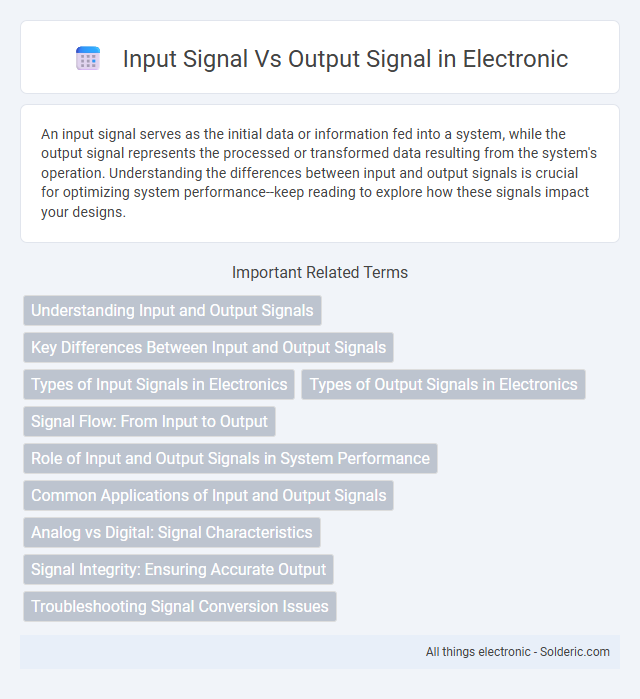An input signal serves as the initial data or information fed into a system, while the output signal represents the processed or transformed data resulting from the system's operation. Understanding the differences between input and output signals is crucial for optimizing system performance--keep reading to explore how these signals impact your designs.
Comparison Table
| Aspect | Input Signal | Output Signal |
|---|---|---|
| Definition | Original signal fed into a system or device | Processed signal produced by a system or device |
| Purpose | To provide data or stimulus for processing | To deliver results after system processing |
| Nature | Raw, unaltered data | Modified, amplified, or filtered data |
| Signal Quality | May contain noise or interference | Typically enhanced or conditioned |
| Examples | Microphone audio, sensor data | Speaker output, display signals |
| Measurement | Voltage, current, frequency before processing | Voltage, current, frequency after processing |
| Role in Systems | Input for circuits, software, or systems | Output delivering actionable information |
Understanding Input and Output Signals
Input signals represent the data or information fed into a system for processing, often in the form of electrical, optical, or digital waveforms. Output signals are the processed results produced by the system, reflecting changes made to the original input based on specific operations or functions. Understanding the relationship between input and output signals is crucial for analyzing system performance, ensuring signal integrity, and optimizing communication or control processes.
Key Differences Between Input and Output Signals
Input signals originate from sensors or user devices and carry raw data or control information into a system for processing. Output signals represent the processed, transformed data or commands sent from the system to actuators, displays, or other devices to perform specific actions. Understanding the distinct roles of input and output signals is crucial for optimizing your system's accuracy, efficiency, and responsiveness.
Types of Input Signals in Electronics
Input signals in electronics vary widely and include analog signals, such as continuous voltage or current variations, and digital signals, which consist of discrete binary levels representing data. Other types involve pulse signals that convey information through rapid changes in amplitude or frequency, and complex modulated signals used in communication systems. Your choice of input signal type directly affects the design and performance of the output signal in electronic circuits.
Types of Output Signals in Electronics
Output signals in electronics vary widely, including analog signals characterized by continuous voltage or current changes, and digital signals that switch between discrete levels representing binary states. Common types of output signals include pulse-width modulation (PWM) used for motor control, voltage output for driving analog circuits, and current output employed in sensor interfaces. Advanced systems may also utilize frequency output signals for communication and control applications, enhancing the precision and versatility of electronic devices.
Signal Flow: From Input to Output
The input signal initiates the process by entering the system, where it undergoes various transformations such as amplification, filtering, or modulation. This processed signal then flows through internal components, maintaining integrity and quality to ensure accurate representation. Your output signal reflects the final, optimized version ready for transmission, recording, or further usage.
Role of Input and Output Signals in System Performance
Input signals act as the primary drivers that initiate and influence the functioning of a system by providing essential data or stimuli. Output signals reflect the system's response and effectiveness by representing processed information or actions derived from the input. Optimizing the relationship between input and output signals is crucial for enhancing system performance, accuracy, and reliability in various applications.
Common Applications of Input and Output Signals
Input and output signals are fundamental in control systems, where input signals represent sensor data such as temperature, pressure, or light intensity, and output signals drive actuators like motors, valves, or display units. In industrial automation, input signals from sensors trigger output signals that control machinery operations, ensuring precise manufacturing processes and system safety. Communication systems rely on input signals for receiving data and output signals for transmitting processed information, enabling efficient data exchange and network functionality.
Analog vs Digital: Signal Characteristics
Analog signals vary continuously, representing information through voltage or current changes that correspond directly to physical phenomena, while digital signals use discrete binary values (0s and 1s) to encode data for precise processing and noise resistance. Analog signals exhibit infinite resolution and are susceptible to degradation over distance, whereas digital signals maintain integrity through regeneration and error correction methods. Your choice between analog and digital signal types impacts system performance, accuracy, and noise tolerance depending on the application's requirements.
Signal Integrity: Ensuring Accurate Output
Maintaining signal integrity between input and output signals is critical for accurate data transmission and system performance. Factors such as noise, distortion, and impedance mismatches can degrade the output signal, resulting in information loss or errors. Utilizing proper shielding, impedance matching, and signal conditioning techniques preserves the fidelity of the output signal relative to the original input.
Troubleshooting Signal Conversion Issues
Troubleshooting signal conversion issues requires analyzing both the input signal's integrity and the corresponding output signal accuracy to identify discrepancies. Signal attenuation, noise interference, and improper impedance matching often cause distorted output signals during conversion. You can resolve these issues by ensuring proper calibration of converters and using quality cables to maintain signal fidelity.
input signal vs output signal Infographic

 solderic.com
solderic.com